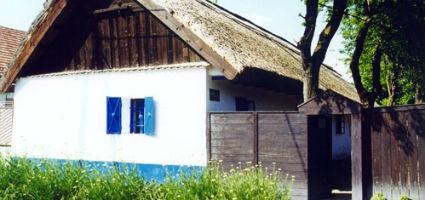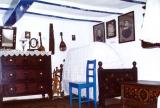2024. April 20. Saturday
Petőfi House and Memorial Museum - Slovakian Region House - Kiskőrös
 |
Address: 6200, Kiskőrös Szent István utca 23.
Phone number: (78) 414-255, (78) 312-566
E-mail: petofimuzeum@koroskabel.hu
Opening hours: Tue-Sun 9-12, 13-16
|
The Slovakian population played an important part in the history of the New Age of Kiskőrös. At the time of the Turkish reign the people of the town either were slaughtered or ran away. The condition of life in the town had to be recreated. A lord of the Wattay family recognized it and brought settlers from Upper Hungary. The families from the Counties Túróc, Hont, Nyitra, Árva, and Bratislava were Evangelic Slovakians. They bought their traditions, languages with them, but they also accommodated to their new environment fast.
Ever since then the settlement still has the characteristics of the Slovakian culture on it. The older generation kept its language, culture, and religion. The younger generation only kept their religion, they hardly speak the language, the cultural and ethnographic traditions are preserved only for the sake of keeping the tradition but they are not in actual use. The newcomers formed their practice of religion, their education, they built schools and churches, but it was also important for them to learn Hungarian. Sermons in Hungarian were kept regularly.
The Slovakian also adapted to the possibilities provided by the land. They learned to till the land, to farm, and viniculture. They soon learned of the traditional folk art of the area. Some of the motifs of Kalocsa were included in their folk art; the pottery of the people living here original was mixed with that of the newcomers. The folk clothing however is purely Slovakian.
The life, way of thinking, and cultural costumes of the population that settled here over 280 years ago is a worthy heritage for the upcoming generations. Thus, the credible and the rich collection is a valuable source of researches.
The peasant house under the address of 23, Saint Stephen Street is a comfortable, thatched roofed house. The life, culture, and objects of the peasants can be learned of at our exhibition.
Mrs. Kispál Dr. Ilona Lucza
Ever since then the settlement still has the characteristics of the Slovakian culture on it. The older generation kept its language, culture, and religion. The younger generation only kept their religion, they hardly speak the language, the cultural and ethnographic traditions are preserved only for the sake of keeping the tradition but they are not in actual use. The newcomers formed their practice of religion, their education, they built schools and churches, but it was also important for them to learn Hungarian. Sermons in Hungarian were kept regularly.
The Slovakian also adapted to the possibilities provided by the land. They learned to till the land, to farm, and viniculture. They soon learned of the traditional folk art of the area. Some of the motifs of Kalocsa were included in their folk art; the pottery of the people living here original was mixed with that of the newcomers. The folk clothing however is purely Slovakian.
The life, way of thinking, and cultural costumes of the population that settled here over 280 years ago is a worthy heritage for the upcoming generations. Thus, the credible and the rich collection is a valuable source of researches.
The peasant house under the address of 23, Saint Stephen Street is a comfortable, thatched roofed house. The life, culture, and objects of the peasants can be learned of at our exhibition.
Mrs. Kispál Dr. Ilona Lucza
